News
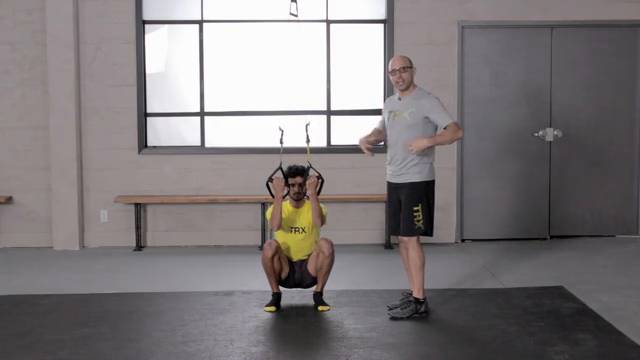
For the Love of the Run Week Three: Lower-Body and Core Strength for Runners
As a runner, developing integrated lower and upper-body strength, especially through your core, will result in a more powerful and efficient stride. Though it may seem a little counter-intuitive, your upper body and core actually play a big part in generating power and maintaining stability while you run.
Try these three TRX exercises for creating core strength, stability and mobility in runners and watch your performance soar:
TRX Bottom Up SquatLogic:Improve mobility in the hips and ankles while warming up the entire body for any training session. This exercise also teaches you how to engage your core and arms to improve your running posture, key for efficient breathing and arm drive.
Set Up:Stand facing the anchor point holding the TRX handles in front of you with your feet about hip width apart. Squat down and curl yourself up with your arms. Hop around a little until you get in a position where you feel like you could let go of the Suspension Trainer and you wouldn’t fall back.
Movement:Brace your core and drive through your feet to stand up. As you stand up, rotate your palms around until you are performing a triceps press.Reestablish your plank at the top of your squat.
Return:Lower your hips down and back to return to the bottom of the squat.
TRX Hamstring RunnerLogic:Develop your posterior chain, hamstrings, lower back and glutes to help correct imbalances not only from front to back, but also from side to side.
Set Up:Lay on your back with your heels in the foot cradles, directly under the anchor point. Drive your heels down, squeeze your glutes and brace your core to lift your hips. Imagine you are performing a plank on your back.
Movement:Without letting the straps slip, draw one knee toward you and keep your other leg out straight. Try to focus more on keeping your non-moving leg straight, instead of your moving leg.
Return:Press your foot back out and repeat on the opposite leg.
TRX Chest PressLogic:Think of this move as a moving plank instead of a chest and arm exercise. With this movement you are developing integrated core strength and stability to improve your running posture and arm drive.
Set Up:Stand facing away from the anchor point holding the handles of the Suspension Trainer out in front of you. Brace your core and lean your weight into the handles, making sure your hips, shoulders, knees and ankles are all in line.
Movement:Bend your arms at the elbows to lower yourself down in one controlled motion until your palms are at the side of your chest.
Return:Brace your core and squeeze your glutes to reestablish your plank, then drive your hands through the handles until your arms are fully extended out in front of you.
Recommended Workout Sequence:TRX Bottom Up Squat: 5-10 repsTRX Hamstring Runner: 5 reps on each legTRX Chest Press: 5-10 reps
For more running-specific workouts from TRX go here.
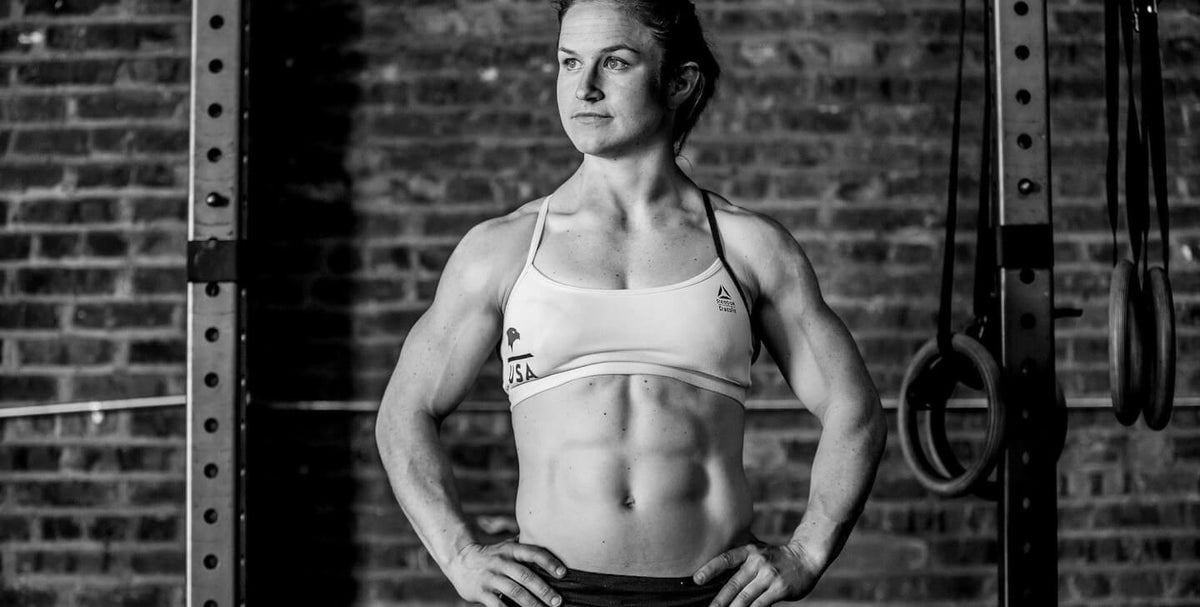
Food for Thought: What Kari Pearce Eats Before, After, and During Competition
Kari Pearce has used TRX training tools for years, first as a gymnast, and now as one of the world’s top CrossFit athletes. This summer, TRX is chronicling Kari’s journey to the CrossFit Games with a weekly series about her training program.
“It makes me feel better to eat right and train properly,” elite CrossFitter Kari Pearce says. “I notice a difference in how my body feels.” For Pearce, that means consuming clean, whole foods, and the occasional Lucky Charms. But more on those later.
Pearce has been an athlete her entire life—from gymnast to bodybuilder to CrossFitter—but she became more thoughtful about her diet after she finished college. “When I was gymnast, I tried to eat healthy, but I also ate a lot of other junk. I didn’t pay as much attention to my nutrition or think about how it would affect my performance,” she recalls. One obstacle was that certain foods—like yogurt or granola—sound healthy, but frequently hide unnecessary sugar and additives. “Now that I’m older, I enjoy learning about it, changing things and seeing how my body reacts,” she says.
With the CrossFit Games approaching, and her workouts ramping up, Pearce is extra-careful about her food choices. She works with Renaissance Periodization, (a company that uses science and research to create food programs for athletes), and Kettlebell Kitchen, (a Brooklyn-based meal service), to ensure she’s getting exactly what her body needs to perform.
Pearce eats as many as five small meals and a protein shake during a day. It’s not just a matter of eating frequently, but choosing the right balance of food categories. On a typical day, she has a combination of chicken, eggs, veggies, peanut butter, and lots of oatmeal. (“It’s easy. You can carry it anywhere. You just need hot water to cook it. It’s one of the things I carry most with me when I travel,” she says.)
Portion sizes vary according to the time of day—and what time she’s working out—but Pearce consumes as much as 75 grams of carbs, 3 ounces of protein, 1–2 servings of fat, and vegetables in a single meal. “My favorite meal is chicken with grilled peppers and onions, black bean salsa, and avocado. I think I could eat that for the rest of my life if someone would cook it for me everyday,” she says. Her vitamins and nutrients come from food—the only supplement she takes regularly is fish oil—and she doesn’t drink alcohol. “I don’t really enjoy it,” she says. “If I’m going to get extra calories, I want ice cream, not alcohol.”
Even when she travels, Pearce sticks to her meal plan by packing a cooler with prepared meals, or finding a hotel room with a kitchen so she can do her own meal prep. In a bind, she eats oatmeal or canned tuna. “I’ll go out some,” she says, “but I try to eat as much of my food as I can. If I eat out and I eat junk, I can really feel the difference in my energy levels.”
Traveling for CrossFit Regionals or the CrossFit Games requires a little extra meal packing...and a “magically delicious” snack. For her last Regional competition, Pearce’s consultant at Renaissance Periodization wrote her a nutritional program, and recommended a simple sugar between events. Yes, he actually told her to eat Lucky Charms. The cereal has been her favorite for years; Pearce says her dad even discovered chocolate Lucky Charms when she was in college, and would bring her boxes when he visited. “So I eat Lucky Charms with some lean chicken or protein [during competition],” she admits. “I just bring a big bag of Lucky Charms with me.”
After competition, Pearce goes out for Mexican food—she loves fish tacos, guacamole, and fajitas—and ice cream. Then it’s back to the meal plan. Because even if she tops the podium at this year’s Games, there’s always another goal to train for.

General
For the Love of the Run: Leg Strength and Core Stability for Runners
TRX Training
Imbalances in your leg strength and mobility between your left and right side can give you an uneven and inefficient stride. Over time, these imbalances can lead to overuse injuries.
These TRX exercises provide an excellent way to recognize, improve and ultimately, overcome those imbalances. Want to find exercises that address your specific muscle imbalances? Take our quick assessment quiz to get a personalized training plan. So you can do what you love, longer and more pain free.
TAKE OUR TRAINING QUIZ
Here's what you'll need:
TRX® PRO4 SYSTEM
BUY NOW
PRO4 RUNNER BUNDLE
BUY NOW
TRX® TRAINING MAT
BUY NOW
TRX Forward Lunge to I Fly (Advanced Progression) Logic:This exercise develops mobility in your hip flexors, stability in your core and improves single-leg balance and coordination, all helpful components in evening out your stride. If you’ve already mastered this progression of the exercise, try trailing the hand of your working leg and alternate from side to side to increase the stretch and develop some running-specific coordination.
Set Up:Stand facing away from the anchor point holding the handles with your hands and your arms straight out in front of you.
Movement:Lunge forward until your front knee is bent at 90 degrees, letting the knee of your trail leg kiss the ground. As you lunge down, your arms should go directly overhead, unloading your legs slightly so you can focus on the stretch.
Return:Brace your core, press your hands into the handles and drive through your front foot to return to the start. Reestablish your plank before repeating on the other side.
TRX Single Arm RowLogic:Not only with this move improve your arm drive and posture, making your run more efficient and powerful, but it also will improve durability. Because we’ve modified this to a single-arm progression, you’ll be resisting rotation the entire time, helping you develop better 360-degree stability so your can better handle the high impact and changing surfaces while you’re running.
Set Up:Stand facing the anchor point and lean back while holding your self up with the Suspension Trainer in one hand. Brace your core and focus establishing a strong plank with your shoulders pulled down and back.
Movement:Maintaining your plank, use your back muscles to pull your chest up to your hand. It can be helpful to use your non-working hand to mirror your working hand ensuring you’re body is totally even, throughout the movement.
Return:Lower yourself down in one slow, controlled movement.
TRX Suspended LungeLogic:Probably one of the single best exercises you can do to recognize and correct imbalances between your left and right sides, there is no hiding from this move. Core strength, single-leg stability, balance, mobility- this exercise has it all.
Set Up:Stand facing away from the Suspension Trainer with one leg through both of the foot cradles. Ground yourself through your working leg and find your plank before you start moving.
Movement:Push your hips down and back, and lunge down until your front knee is bent to 90 degrees. Keep your core braced and your chest up the entire time, and let your arms match your stride pattern, mimicking the way your run.
Return:Drive through your front foot and use your glute and hamstring to bring you back up to the top. Pause for a moment to reset your plank before starting the net rep.
Recommended Workout Sequence:TRX Forward Lunge to I Fly: 5-10 reps on each sideTRX Single Arm Row: 5-10 reps on each sideTRX Suspended Lunge: 3-8 reps on each side
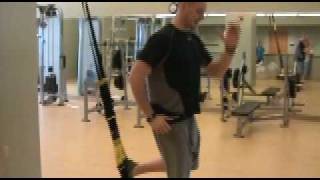
Five TRX Exercises for Basketball Players
With March Madness in full force, we figured that many of you out there might want a little basketball-inspired training to work out your broken-bracket aggression.
TRX Director of Human Performance Chris Frankel hand picked these five exercises to help basketball players improve their quickness, agility, power, explosiveness and leaping ability. Want to find the perfect TRX exercises to enhance your game? Take our quick assessment quiz to get a personalized basketball training plan.
TAKE OUR TRAINING QUIZ
In the video above, TRX Instructor Casey Stutzman takes you through our "starting five" TRX exercises designed to help get you game ready. They are:
TRX Lunge - Builds single leg strength, deceleration, acceleration and balance, works the posterior chain and integrates functional core strength all at once
TRX Atomic Push-up - Integrates chest and shoulder stability, core strength, power and high intensity cardio training
TRX Side Plank - Develops lateral core strength and stability
TRX Crossing Balance Lunge - Works the hips, legs and core in a multiplanar single leg stance
TRX Power Pull - Integrates multiplanar back, shoulder and core training in a standing position
As always, make sure you warm up properly and select the appropriate intensity for your fitness and ability level. See you on the court!
Get your TRX Suspension Trainer here.
Casey Stutzman is a TRX Instructor and travels the US teaching TRX Professional Education Courses. Casey has been using TRX Training for over three years in his role as Head Trainer at Bay Athletic Club in Alpena, Michigan as well as coach of the Alpena High School girls' basketball team. He holds certifications through the American Fitness Association of American (AFAA) as well as Under Armour’s Combine 360. Casey is also a competitive bodybuilder.

FitDeck: TRX Suspension Trainer
Just when you thought that we could not make the TRX any more fun, we went and made a game out of it. We have partnered with FitDeck, the fitness deck of cards to help build a foundation of fitness by creating hundreds of basic workouts that are, simple, convenient and fun. Together we developed the FitDeck TRX Suspension Trainer. This deck of cards is specifically designed to challenge your exercise routine and keep it fresh and interesting.
This deck of 26 cards can be used on their own or combined with other FitDecks to maximize your possibilities. The simplest way to use the deck is to shuffle the deck, pull the top card, do the exercise and then work your way through the pile. But that is not the only way to use it. Check out FitDeck's suggested games or come up with some of your own.
We at TRX have always been dedicated to making fitness challenging and fun and what better way than to make a game out of it! Want to discover workouts that match your idea of fun fitness? Take our quick assessment quiz to get personalized exercise recommendations that keep you motivated and engaged.
TAKE OUR TRAINING QUIZ
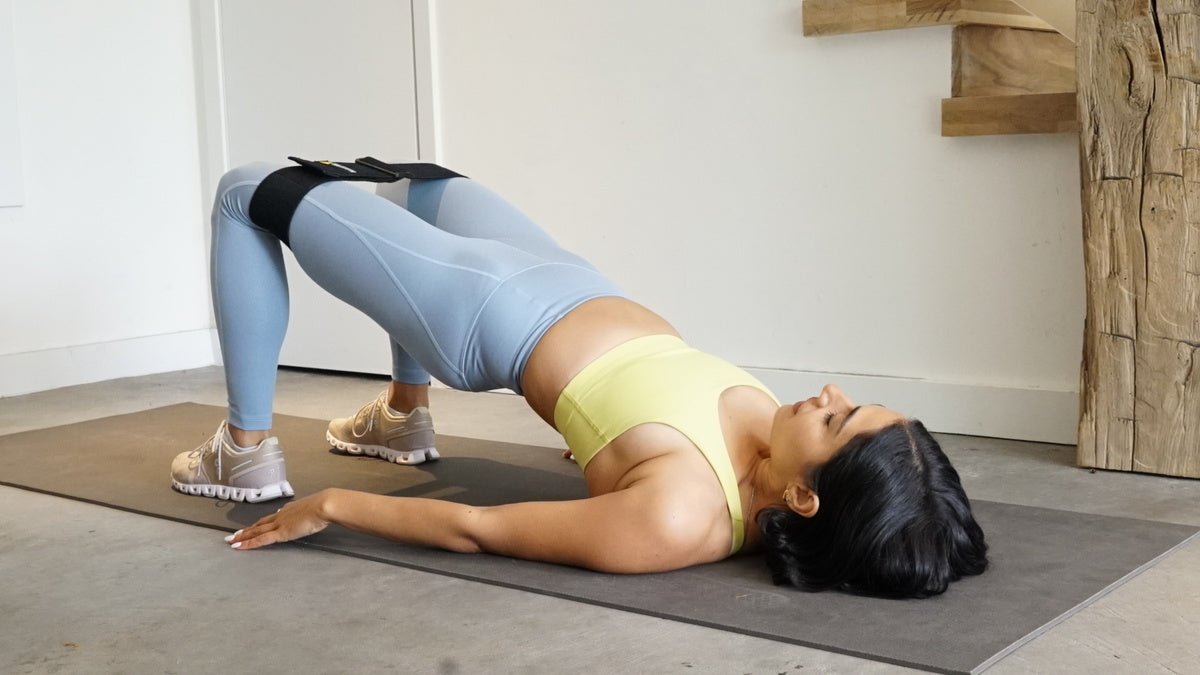
Everything You Need to Know About Resistance Bands
TRX Training
If your TRX Training ClubSM workout calls for Strength Bands or any other type of resistance training equipment, do you automatically know which elasticized accessory to grab? Want to find the right resistance bands for your fitness goals? Take our quick assessment quiz to get personalized equipment recommendations. There are lots of bands in the fitness world, and most people don't know which one's which. That changes now. We're doing a deep dive into everything you need to know about TRX Strength Bands, Glute Bands, and Exercise Bands. In just a few minutes, you'll be a band expert.
TAKE OUR TRAINING QUIZ
Oh, the Many Bands You’ll Meet
The smallest, lightest bands on the block are the Exercise Bands. They’re a continuous loop made from rubber latex, and are about 10 inches in diameter. (Think: giant rubber band, specifically made for fitness.) Exercise bands are usually reserved for low-impact training, rehabilitation, stretching and mobility.
While you can easily program a full-body, 30-minute workout using only an Exercise Band, you’ll usually spot these being used for isolated hip work and rotator cuff targeting. For example, you could place a lightweight Exercise Band around your forearms while planking, or slide a medium or heavy Exercise Band around your thighs to drive up the intensity of squats or planks.
For a booty-boosting workout, TRX Glute Bands are your new best friend. Unlike the Exercise Bands, our Glute Bands are made from fabric and they’re velcro-adjustable. Available in light, medium, and heavy resistance, they won’t pull at your skin or hair.
Also, did we mention they’re crazy-effective for toning the glutes and hip flexors? Even the “light” Glute Band delivers enough burn to make you double check the label.
Rounding out the collection are the Strength Bands, which are approximately 3-ft. long, continuous, heavy-gauge rubber loops. They’re the ones usually hanging on the wall at the gym because, frankly, most folks find them uncomfortable. Even TRX founder Randy Hetrick, a former Navy SEAL, admitted that he used to avoid Strength Bands because they pinched his hands. That’s why he created the TRX Bandit, a universal handle that lets Strength Bands finally—finally!—realize their potential.
Slip the Bandit over (almost) any Strength Band, and you’ve got a high-impact, low maintenance system for squats, curls, presses, and rotational power.
Before we move on from identifying bands, let’s not forget about that other on-the-go tool that we all love: The Straps! The TRX Suspension Trainer™ is not elastic, but it’s still a one-size fits all strength training superstar. When you’re looking to add extra burn to your Suspension Training® workout, try adding Exercise Bands to TRX Rows, Bicep Curls or Tricep Dip, or Glute Bands to any of your TRX Planks.
If you want quality tension, get your resistance bands here today:
TRX® RESISTANCE BANDS
BUY NOW
TRX® STRENGTH BANDS
BUY NOW
TRX® GLUTE BANDS
BUY NOW
Why are people obsessed with bands?
Resistance bands are affordable, portable, and efficient—a triple threat that can appeal to any fitness enthusiast.
First, let’s talk affordability. We’re not saying that bands are the best or only way to workout, but they’re the cheapest option that doesn’t cut back on quality.
Basic, lightweight TRX Exercise Bands cost less than $4 each, or you can buy a full set for less than $15. TRX Strength bands, which you can use as a substitute for weight-training exercises, start at $10.95. Even our most expensive resistance bands, the TRX Glute Bands, are only $39.95 for a set of three, plus they come with their own mesh travel bag. (Pro-tip: the bag is big enough to fit the Exercise Bands, too, if you want to store everything in one place.)
Next, there’s the portability factor. Maybe you’re the person who brings a collection of kettlebells wherever you go, but the average person doesn’t want to lug extra weight. Resistance bands produce similar benefits to weights, but they’re lightweight and compact. You want a gym you can squeeze into a fanny pack? Invest in bands.
Finally, there’s the efficiency consideration. Whether you opt for Exercise Bands for light toning, or Strength Bands outfitted with the new TRX Bandit as a substitute for cable-powered lifting, bands give you the freedom to crush serious workouts absolutely anywhere.
Ready to move?
You didn’t think we could tell you everything you need to know about resistance bands without sharing workout suggestions, did you?
Exercise Band Extras
In a plank position, try adding TRX Exercise Bands around your forearms (in a high plank) or above your elbows (in a low plank) to challenge both your upper body mobility and your core stability. Trust and believe, the burn will set in fast. You can also try slipping an Exercise Band over your feet—around midfoot—for an amped-up Mountain Climber, Bicycle Crunch, Dead Bug, or Slow March.
Bonus Points on the Straps: Remember you can add the Exercise Band around your forearms when using your Suspension Trainer for upper body exercises like TRX Rows and Tricep Dips!
Glute Band Burn
Whether you’re squatting with bodyweight or loaded weights, adding a Glute Band will shred your bum in the best way. Start with a basic squat, then experiment with jumps or lateral squat steps. When it’s time to hit the mat, you could also use the Glute Band to drive up the intensity of Fire Hydrant Lifts or Donkey Kicks.
Bonus Points on the Straps: Slip on a Glute Band before you rep out your TRX Front Squats, Planks, or Pikes. Warning: May result in extreme soreness and bragging rights.
Strength Bands For the Win
Armed with your Bandit handles, there’s no limit to what you can do with Strength Bands. Consider super-setting exercises, first with your bands, then with your Suspension Trainer to compare how different tools affect your movement. Start with a Bandit Squat paired with a TRX Squat, then try a Bandit Chest Press with a TRX Chest Press, and finish with Bandit Lateral Raises followed by TRX Y-Flies.
There’s plenty of room in the fitness world for weights, Suspension Training®, and resistance. Look past the “either/or'' dilemma when choosing gear, and embrace introducing tools like resistance bands to keep your body guessing. Remember, change makes your workouts interesting and enjoyable, and increases their overall effectiveness.
Still looking for more tips and tricks with bands? Don’t forget that you can filter TRX Training ClubSM on-demand videos for the specific equipment you’re using, including Strength Bands, Glute Bands, Exercise Bands, Bandit, and—of course—the Suspension Trainer.
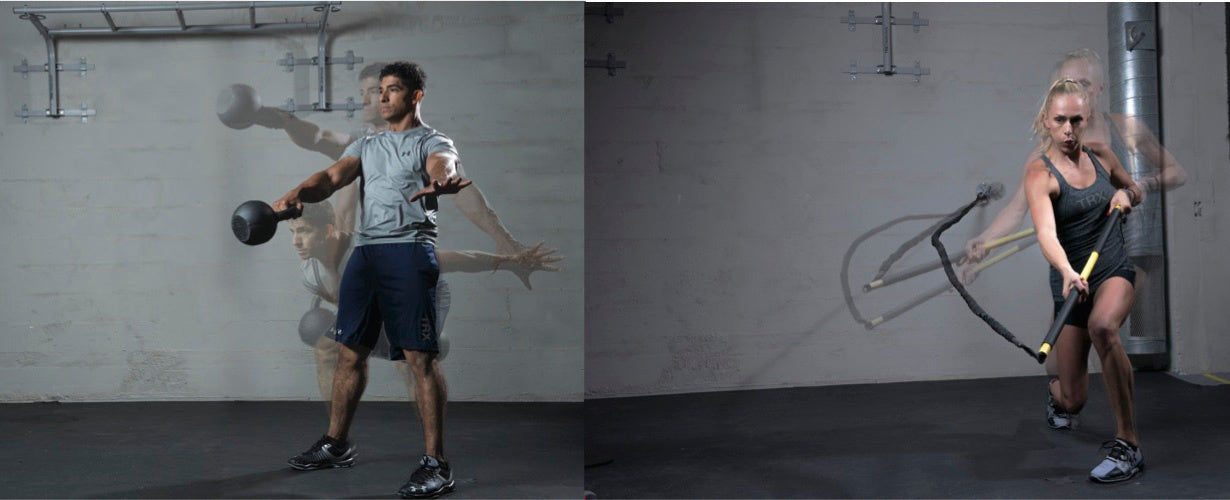
Everything You Need to Build the Ultimate Golfer Home Gym
Depending on whom you ask, the game of golf is approximately 250 to 450 years old. But, despite its advanced age, there’s been a major shift in golf over the last 20 years: top players have branched out beyond technical skills and found ways to improve their game through fitness. Even if you’re not vying for endorsement deals or a spot on the PGA Tour, the right exercises can help you play better on the course, and feel better after the game is over. Want to build the ultimate golfer home gym? Here are five tools that experts recommend to help you train to be a better golfer.
TRX Suspension Trainer ($199.95)
Whether you’re using it at home, at the gym, or setting it up on your golf cart, the Suspension Trainer gives golfers a quick way to build in resistance training and core work. Chris Frankel, TRX Head of Human Performance and a former PGA Tour trainer, says even the pros love this tool. Frankel recommends packing it for pre-game exercises to open up the chest, loosen up the shoulders, and activate the core before hitting the green. Don’t forget to warm up with the TRX Golf Rotation!
TRX RIP Trainer ($199.95)
The RIP Trainer is perfect for golfers who want to improve their range of motion, particularly through the upper thoracic spine, shoulders, and hips. Golf coaches and fitness professionals love that the RIP Trainer emphasizes every degree in the range of motion to help identify weaknesses in rotational movement. It’s the ideal way to combine ground reaction force, rotational power, and body awareness to improve your golf game.
Kettlebells ($34.95-$119.95)
If you want to improve your drive, you have to focus on getting force into the ground. Kettlebells can help. Start with simple deadlift exercises, and then work on developing a strong kettlebell swing. Kettlebell exercises can increase strength and power in your hips and help you drive the ball further.
Slam Balls ($29.95-$84.95)
Slam ball exercises improve both your overhead mechanics and your power into the ground. Taking time for simple rotational work with a slam ball can help you manage your footwork, your pivot mechanics through your legs, and your swing.
TRX Power Bag ($89.95-$99.95)
This is not your typical weight machine. The Power Bag offers limitless range of motion, all the better for identifying and strengthening your weaker points and motions. It’s ideal for challenging strength and balance. (For more Power Bag training tips, check out this article.)
If you love golf and you spend hours of your life playing the game, take some time to improve your game when you’re away from the course. These five tools—less than $600 total—are the best way to start your very own golfer home gym.
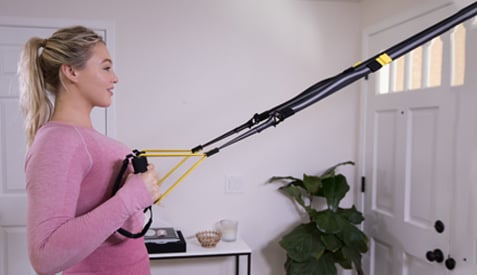
Don’t Be Intimidated By the TRX Suspension Trainer
Most things that intimidate us really aren’t all that bad once we understand them. If you’ve been too intimidated to try the TRX Suspension Trainer™, let’s take a moment to discuss some TRX myths versus facts, and why those black and yellow straps are actually so easy to setup and so easy to use for a full-body workout.
MYTH: TRX is too hard.FACT: TRX is only as difficult as you make it.
The TRX Suspension Trainer is the most adaptable piece of fitness equipment you’ll ever find–it actually utilizes your bodyweight for exercise and for the level of intensity.
To clarify...If you weigh 150 pounds, does that mean that every rep on the Suspension Trainer is loaded with 150 pounds? Absolutely not.
In most basic TRX moves, at least some part of your body will be connected with the ground, whether it’s your upper body or lower body. That connection means you don’t have to be 100% responsible for your weight when completing exercises. In fact, some exercises can be easier with the TRX than when you use bodyweight alone.
Let’s use a push-up as an example. In a standard push-up, your hands and feet are connected with the ground, and they have to support your bodyweight as you raise and lower yourself. With a TRX Chest Press, by contrast, you’re using the same form and muscles that you would with a standard push-up, but you can adjust your angle to increase or decrease the level of intensity, making the move easier or harder. In that TRX Chest Press, the closer you walk your angle forward to stand perpendicular to the floor, the easier it will be. The further you walk it back to parallel with the floor, the harder it will be.
The result is anyone can use a TRX Suspension Trainer: beginners, fitness junkies, young people, old people, adaptive athletes, professional athletes, and more. It is a universal tool that anybody can use anywhere.
MYTH: TRX is too easy.FACT: TRX is only as easy as you make it.
Now we’re on the flip side of the difficulty argument. The Suspension Trainer serves different functions for different people. For most people—novices all the way to professional athletes—it’s the ideal strength and conditioning tool on its own. For athletes chasing gains, try incorporating additional equipment into a TRX workout. That could be adding a wall ball or slam ball to a TRX Lunge, or increasing your load by strapping on a weighted vest before your TRX Squats, Rows, or Chest Presses. Bodyweight is just the start, not the limit of TRX strength training.
Even if you’re into CrossFit or Olympic lifting, the Suspension Trainer is excellent for warm-up, recovery, and mobility work. For example, CrossFit’s Fittest American Woman, Kari Pearce, said she uses her TRX Suspension Trainer for both workouts and recovery stretching. In fact, she often keeps her TRX Suspension Trainer with her in her backpack. “Probably 70 percent of the time, I carry it with me around New York City. When I have a little break, I go to Central Park and hook it up on the pull-up bars,” she said. While Pearce’s training incorporates more heavy weightlifting, she regularly uses her TRX Suspension Trainer for muscle activation exercises.
MYTH: I don't know how to set-up a TRX Suspension Trainer.FACT: Set-up is simple and can take less than a minute.
Even in your home, it’s easy to use your straps practically anywhere. The TRX Suspension Trainer can be set-up on any hinged door in your home, office, or hotel room, or using a tree or a sturdy pole like a street lamp or a jungle gym. The TRX HOME2 SYSTEM, your full-body and lightweight, portable gym, comes with a door anchor and a suspension anchor so you can set it up whenever and wherever you want, no tools or drilling necessary.
As part of the TRX HOME2 SYSTEM, you get both the Suspension Trainer, and one year’s FREE access to the TRX App, regularly $49.95, which includes unlimited workouts programmed by world-class trainers. (Yoga, running, HIIT—it’s all in the app!) It’s one of the smartest fitness purchases you can make.
Now that we’ve separated fact from myth, put that information to good use. This is the perfect time to get your TRX HOME2 SYSTEM and start working toward your goals, so what are you waiting for?
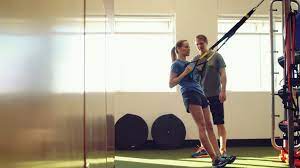
Different Types of Workouts to Consider
Body Transformation Series, Part 4 of 7
“What is the best method for you to train for cardio, strength, endurance or flexibility? The answer depends on what you want to accomplish – the goals of your training. There are several options you can choose from and TRX Suspension Training is an effective, powerful and portable tool which can be part of all of the following techniques.”
Years ago, when prescribing exercise, we used a number of unproven training systems based on the ideas and experiences of well-intentioned physicians, coaches and educators. But exercise science and prescription today is based on the results of thousands of peer-reviewed research studies and best practices of experts in the field. The correct dose is based on the type of exercise being performed, the time, intensity and frequency of training, as well as, your individual needs.
There are many ways to improve fitness. Want to find the perfect progression path for your goals? Take our quick assessment quiz to get a personalized training plan that builds fitness safely and effectively. You can apply a variety of techniques using a systematic approach gradually, or you can rush the process, pushing too far too fast, risking soreness, overtraining and even injury. Improving fitness involves increasing the range of motion and pace of movements, strengthening the muscles of the body both inside and out, decreasing fat and learning to move in a more fluid, uninhibited way. You earn your fitness, minute-by-minute, day-by-day as you engage in appropriate training exercises.
TAKE OUR TRAINING QUIZ
Cherry Picking Programs
There are five traditional components of fitness. All are important and all five need to be considered and respected as part of your complete training program. The five components include muscle strength, muscle endurance, cardiorespiratory endurance, flexibility and body composition. Body composition is a direct reflection of your diet, so your exercise routine is influenced by your body composition and vice versa.
Often people pick and choose the types of exercise they like the best and only train in those modalities. For example, some people only like cardio, running for miles a week but neglecting muscular strength and flexibility and as a result find themselves chronically injured or not progressing as effectively as possible. Others prefer strength training, with limited range of motion at joints that are critical to daily, functional activity, with very little aerobic fitness to boot. In both of these scenarios, regardless of how successful each of these fitness enthusiasts are in their favorite areas of training, they are incomplete, neglecting the very important components that create a completely healthy and fit person. One of the most neglected areas of fitness is flexibility, but it’s very influential on an active lifestyle. A moderate to high level of flexibility and mobility are important for efficient movement. If you disregard stretching, your muscles and connective tissues can lose distensibility and elasticity making exercise less efficient and potentially contribute to injury. Make a point to include flexibility as a regular part of your training program.
The FITT Principle
We know the manipulation of how often (frequency), how hard (intensity), how long (time or duration) and what you want to accomplish (type) is the key to bringing about improvements in fitness. This is referred to as the FITT Principle and there are specific formulas based on your individual training goals. For example, if you are looking for increased aerobic stamina, you will apply the FIIT Principle with aerobic adaptations in mind. If you are looking for greater strength or more muscle size (hypertrophy), there is a FIIT formula for that. If you want greater flexibility, there are FIIT guidelines for that too. What you are trying to accomplish will dictate how to manipulate these FIIT variables.
The American College of Sports Medicine (ACSM) has established FIIT guidelines that are easy to follow based on the modality of fitness you are trying to improve:
FITT Principle for Aerobic Performance (Some general Guidelines)
• Aerobic exercise involves sustained, rhythmic movements using large muscles of the body with oxygen as the primary energy source for extended periods of time. If your goal is performance, you should include training at or near your lactate threshold (the point where you are pushed).
o How Often? (frequency)
Beginner: 3-5 days per week
Moderate to High: 5-7 days per week
o How Hard? (intensity)
Deconditioned: 30-40% of your Heart Rate Reserve (HRR)
Moderate: 40-60% of your HRR
Vigorous: 60-85% of your HRR
To estimate your appropriate heart rate reserve use this equation:
• HRR = 220 – (your age) – (your resting heart rate) x (desired percentage)
o How Long? (time or duration)
Beginner: 20-30 minutes
Moderate to High: 30-60 minutes
o What kind? (type)
A continuous rhythmic activity such as walking, running, cycling, swimming or circuit training. The specific type of exercise you select should be enjoyable to you so you can be consistent. TRX Suspension Training used for body-weight circuit training is an excellent choice because of the variety and ability to change intensity quickly.
FITT Principle for Muscular Strength & Endurance
• Muscular endurance is the ability to perform several, sub-maximal muscular contractions in a row with sustained intensity. Muscular strength is the ability to perform one repetition at your maximal intensity.
o How Often? (frequency)
Beginner: 2-3 days per week, full body workout, 48-72 hours of rest in between workouts
Intermediate to High: 4–5 days per week; perform split workouts (example: Monday and Thursday, chest, shoulders, triceps, abdominals; Tuesday and Friday, back, legs, biceps), 48–72 hours of rest in-between workouts
o How Hard? (intensity)
Beginner: 60-70% of maximum strength (1 RM)
Intermediate to High: 70-90% of maximum strength (1RM)
Beginner: 1-3 sets, 8-12 reps, 30-sec to 1 min between
Intermediate to High: Endurance 12-20 sets, 2-3 reps 30 sec – 1 min between; Strength 2-6 reps, 3-5 sets, 2-5 min between
o How Long? (time or duration)
Depends on the time you need to accomplish your goals, but no more than 60-minutes is necessary
o What kind? (type)
Resistance machines, free weights, elastic tubing, medicine ball, body-weight/calisthenics
FITT Principle for Flexibility
• Flexibility is the uninhibited range of motion through a joint and in the adjacent soft tissues
o How Often? (frequency)
A minimum of 2-3 days per week. It is best to do some stretching daily
o How Hard? (intensity)
Stretch to the point where you feel tension in the muscles, but not pain
During a warm up, stretches should be dynamic, not held. Whereas, later in the workout or at the end of the workout, stretches are held (static stretches)
o How Long? (time or duration)
15-30-minutes, 20-60 seconds for each stretch, 2-3 sets
o What kind? (type)
Yoga, traditional stretching routines, TRX Suspension Training assisted stretching exercises
“With any worthwhile fitness program, you will earn your progressions and perform the exercises with precision and care.”
Various Training Methods
What is the best method for you to train for cardio, strength, endurance, flexibility or concurrent (multiple goals at once)? The answer depends on what you want to accomplish – the goals of your training. There are several options you can choose from and TRX Suspension Training can be an effective part of all of the following training techniques, a powerful, portable tool for performance. With any worthwhile fitness program, you will need to earn your progressions within each exercise and perform the movements with precision and care if you are to realize the benefits and avoid potentially harmful side effects.
Circuit Training
Circuit training involves a series of resistance exercises designed to promote strength and muscle endurance. Circuit training is typically organized in timed, stations of movement, which can be resistance or cardio-based. Incorporate the TRX straps with weights and cardio for an amazing circuit training session.
HIIT
High intensity interval training (HIIT) takes advantage of short, micro bursts of very high intensity exercise, coupled with a short duration of timed recovery. HIIT protocols are very powerful in that they create an “in workout” oxygen deficit in an effort to create EPOC, or excess post-exercise oxygen consumption. EPOC is a physiological condition in which the body is stressed after the workout, utilizing further amounts of energy (above and beyond that required for the actual workout) to replace the used substrates and bring the systems of the body back to resting levels stressed during the HIIT workout. HIIT is powerful if used responsibly but requires recovery between workouts. HIIT protocols (particularly Tabata) are easy to implement using the TRX straps. Try this Tabata protocol using the TRX straps:
4-minutes, 20 seconds of work/10 seconds of recovery for 8 rounds
Round #1 Side Plank Right
Round #2 Side Plank Right with Hip Dip
Round #3 Forearm Plank
Round #4 TRX Push Up
Round #5 Side Plank Left
Round #6 Side Plank Left with Hip Dip
Round #7 Forearm Body Saw with Crunch
Round #8 TRX Pike
Resistance Training
An essential part of improving strength and muscular endurance, resistance training can incorporate body weight, TRX Suspension Training, free weights, weight machines, etc. Traditional strength training techniques, including super sets (2 or more exercises in a row for opposing muscle groups), giant sets (3 successive exercises targeting the same muscle groups), ascending and descending pyramids and eccentric loading, can all happen using the TRX Suspension Trainer. Simply manipulate the TRX intensity variables of Vector, Stability and the Pendulum Principles.
Speed & Power Training
Speed and power training are very activity specific, so if you have a particular goal in mind with respect to speed or power, it is important that you train specifically for that particular goal. Speed is also referred to as velocity. The best way to train for speed is high-speed contractions with low resistance.
Power is Force x Distance / Time. Power combines strength (force) and velocity or speed (distance / time). Power is related to strength and speed – if you can improve one or both of these components, you will increase your power. A popular power training technique is plyometrics, which are explosive movements designed to improve power. However, excessive use or improper technique can lead to injuries. Many TRX exercises lend themselves very well to power and explosive movements. Try the sprinters start, front squat, cycle lunges or the squat jump for lower body power training.
“TRX suspension training is all core all the time, so you never need to worry if you are getting your core training done when using the Suspension Trainer.”
Core Training
The muscles that attach to the spine and pelvis are referred to as the core muscles. Core exercises recruit one or more large muscle areas (abdominal, back, torso, chest, shoulders, and hips) and involve multiple joints. They are a high priority in terms of both health and performance. A stable core can generate a greater transfer of power to the extremities and can also reduce your risk of injury. TRX Suspension Training is “all core all the time,” so you never need to worry if you are getting your core training done when using the TRX straps. Peer reviewed research demonstrates, when used as prescribed, higher levels of core muscle activation are present with Suspension Training than without.
Intensity
Intensity is important, but excessive emphasis on intensity can take the joy out of regular activity and may lead to overtraining, overuse or even injury. Athletes don’t train at maximal intensity every day, nor should you. If you use a heart rate monitor to measure your intensity, be sure to also include a subjective measure of intensity (perceived exertion), and listen to your body. Adopt the intensity gradually, enjoy the experience and the amazing results will come.
Irene Lewis-McCormick M.S is Adjunct Faculty at Drake University, an SCW Fitness Education (SCW) Certification Master Trainer and the Education Director at Octane Fitness. An Orange Theory Fitness coach, she’s a twice published author (Human Kinetics) holding advisory board positions with Diabetic Living and the National Egg Council. Named Top 3 Group Fitness Instructor 2015 by IDEA Health & Fitness, Irene is a RYKA Ambassador and Subject Matter Expert for ACE. Irene presents education for SCW, ACSM, IDEA and NSCA. She is an SCW, TRX, Tabata Bootcamp, Barre Above, JumpSport and Octane Fitness master trainer. Certifications include SCW, ACSM, NSCA, ACE, AFAA & AEA.
Body Transformation Series, Part 1 of 7 Body Transformation Series, Part 2 of 7
Body Transformation Series, Part 3 of 7
Body Transformation Series, Part 4 of 7
Body Transformation Series, Part 5 of 7
Body Transformation Series, Part 6 of 7
Body Transformation Series, Part 7 of 7
